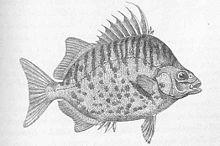Spotbanded scat
| Spotbanded scat | |
|---|---|

| |
| Scientific classification | |
| Domain: | Eukaryota |
| Kingdom: | Animalia |
| Phylum: | Chordata |
| Class: | Actinopterygii |
| Order: | Perciformes |
| Family: | Scatophagidae |
| Genus: | Selenotoca Myers, 1936[2] |
| Species: | S. multifasciata
|
| Binomial name | |
| Selenotoca multifasciata (Richardson, 1846)
| |
| Synonyms[3] | |
|
Scatophagus multifasciatus Richardson, 1846 | |
The spotbanded scat,(Selenotoca multifasciata), also known as the striped scat, banded scat, barred scat, butterfish, John Dory, Johnny Dory, old maid, Southern butter-fish or striped butterfish, is a species of ray-finned fish, belonging to the family Scatophagidae, the scats. They are found in the eastern Indian Ocean and southwestern Pacific Ocean.
Taxonomy[edit]
The spotbanded scat was first formally described in 1846 as Scatophagus multifasciatus by the Scottish naval surgeon, naturalist and arctic explorer Sir John Richardson with the type locality given as King George Sound in Western Australia,[4] although this is several hundred kilometres from its known range and is probably an error on the type specimen's label and the type locality should be farther north,[1] and the description was published in the Ichthyology of the voyage of H.M.S. Erebus & Terror.[4] In 1936 the American ichthyologist George S. Myers reclassified Scatophagus multifasciatus in to a new monotypic genus Selenotoca. In 1938, the British ichthyologist Alec Fraser-Brunner described a second species for the genus Selenotoca papuensis from New Guinea but Catalog of Fishes states that this taxon is a synonym of S. multiasciatus,[2] although FishBase lists it as a valid species.[5]
The genus name Selenotoca is a compound of selene meaning "moon" and tokos which means "offspring", the compound word meaning "born of the moon", Myers did not explain the allusion nor is it clear. The specific name means multifasciatus "many banded", a reference to the dark vertical bars on the back and upper flanks of this species.[6]
Description[edit]
The spotbanded scat has a deep, compressed body covered in vert small ctenoid scales.[7] They have a steep dorsal profile to the head, a moderately large eye which has a diameter which is markedly shorter than the length of the rounded snout length. The small, horizontal mouth is not protractile and there are several rows of bristle like teeth on the jaws.[8] The dorsal fin has 7-12 spines and 16 soft rays while the anal fin has 4 spines and 15-16 soft rays.[3] The first spine in the dorsal fin lies flat and there is a deep incision between spiny and soft rayed parts of the dorsal fin. The caudal fin is rounded in juveniles and truncate in adults. The rear margins of the soft rayed parts of the dorsal and anal fins is diagonal.[8] This species attains a maximum total length of 40 cm (16 in).[3] The background colour of this species is greenish or silvery with many dark, vertical bars on the upper flanks and spots, typically smaller than eye, arranged in roughly vertical rows on the lower flanks. The lips are black. The rear margins of the caudal fin and of the soft rayed parts of the anal and dorsal fins have a thin black margin which fades completely in individuals with a standard length longer than 6 cm (2.4 in).[8]
Distribution and habitat[edit]
The spotbanded scat is found from Sulawesi and Papua in eastern Indonesia Papua New Guinea, New Caledonia and northern and eastern Australia.[1] In Australia this species' range extends from Shark Bay in Western Australia along the northern coasts to Sydney in New South Wales.[8] They inhabit brackish mangrove estuaries and coastal freshwater .[9]
Biology[edit]
The spotbanded scat form schools over sandy areas in estuaries and in river mouths. It is an omnivore which feeds on small benthic invertebrates and detritus.[8] There is a venom gland at the base of each spine and a painful wound can be caused if the spines puncture the skin when handling this fish.[7]
Utilisation[edit]
The spotbanded scat is targeted by recreation anglers.[8] Juveniles are collected for the aquarium trade.[3]
References[edit]
- ^ a b c Palmer-Newton, A. (2020). "Selenotoca multifasciata". IUCN Red List of Threatened Species. 2020: e.T161077712A161077718. doi:10.2305/IUCN.UK.2020-3.RLTS.T161077712A161077718.en. Retrieved 20 November 2021.
- ^ a b Eschmeyer, William N.; Fricke, Ron & van der Laan, Richard (eds.). "Genera in the family Scatophagidae". Catalog of Fishes. California Academy of Sciences. Retrieved 21 August 2021.
- ^ a b c d Froese, Rainer; Pauly, Daniel (eds.) (2021). "Selenotoca multifasciata" in FishBase. June 2021 version.
- ^ a b Eschmeyer, William N.; Fricke, Ron & van der Laan, Richard (eds.). "Species in the genus Selenotoca". Catalog of Fishes. California Academy of Sciences. Retrieved 21 August 2021.
- ^ Froese, Rainer and Pauly, Daniel, eds. (2021). Species of Selenotoca in FishBase. June 2021 version.
- ^ Christopher Scharpf & Kenneth J. Lazara, eds. (12 January 2021). "Order Acanthuriformes (part 2): Families Ephippidae, Leiognathidae, Scatophagidae, Antigoniidae, Siganidae, Caproidae, Luvaridae, Zanclidae and Acanthuridae". The ETYFish Project Fish Name Etymology Database. Christopher Scharpf and Kenneth J. Lazara. Retrieved 21 August 2021.
- ^ a b Mark McGrouther (19 January 2021). "Striped Scat, Selenotoca multifasciata (Richardson, 1846)". Australian Museum. Retrieved 21 August 2021.
- ^ a b c d e f Gomon, M.F. & Bray, D.J. (2018). "Selenotoca multifasciata". Fishes of Australia. Museums Victoria. Retrieved 21 August 2021.
- ^ Allen, Gerry (1999). Marine Fishes of Southeast Asia: A Field Guide for Anglers and Divers. Tuttle Publishing. p. 122. ISBN 9781462917075.

